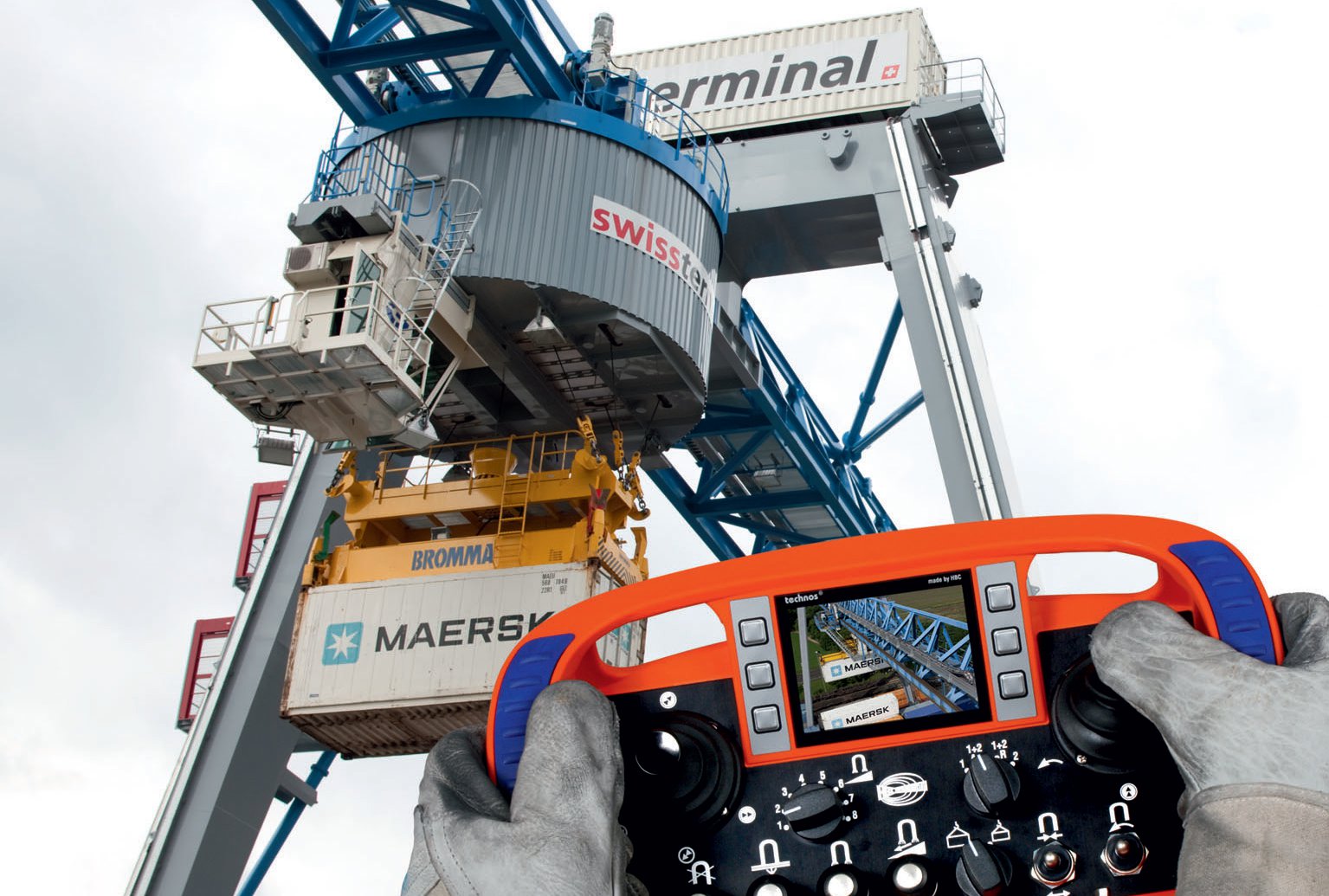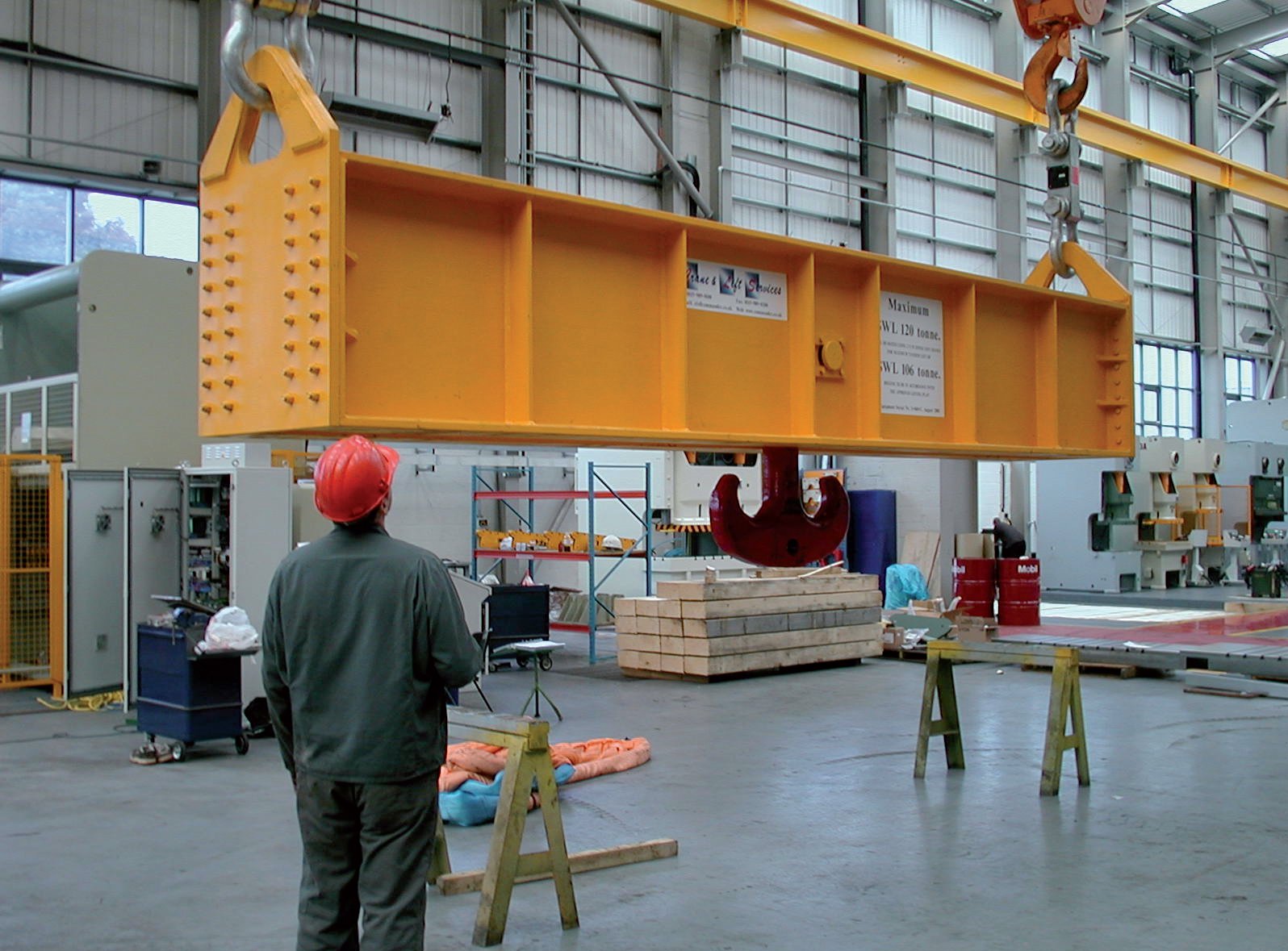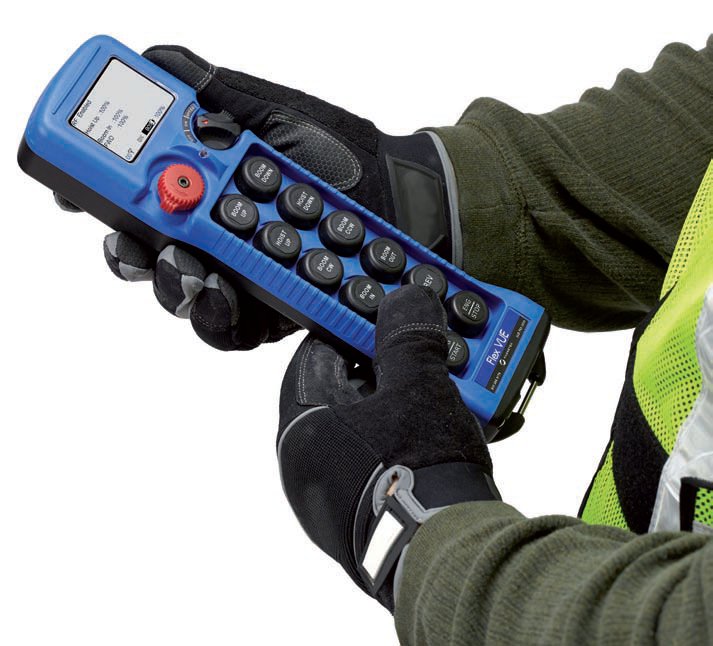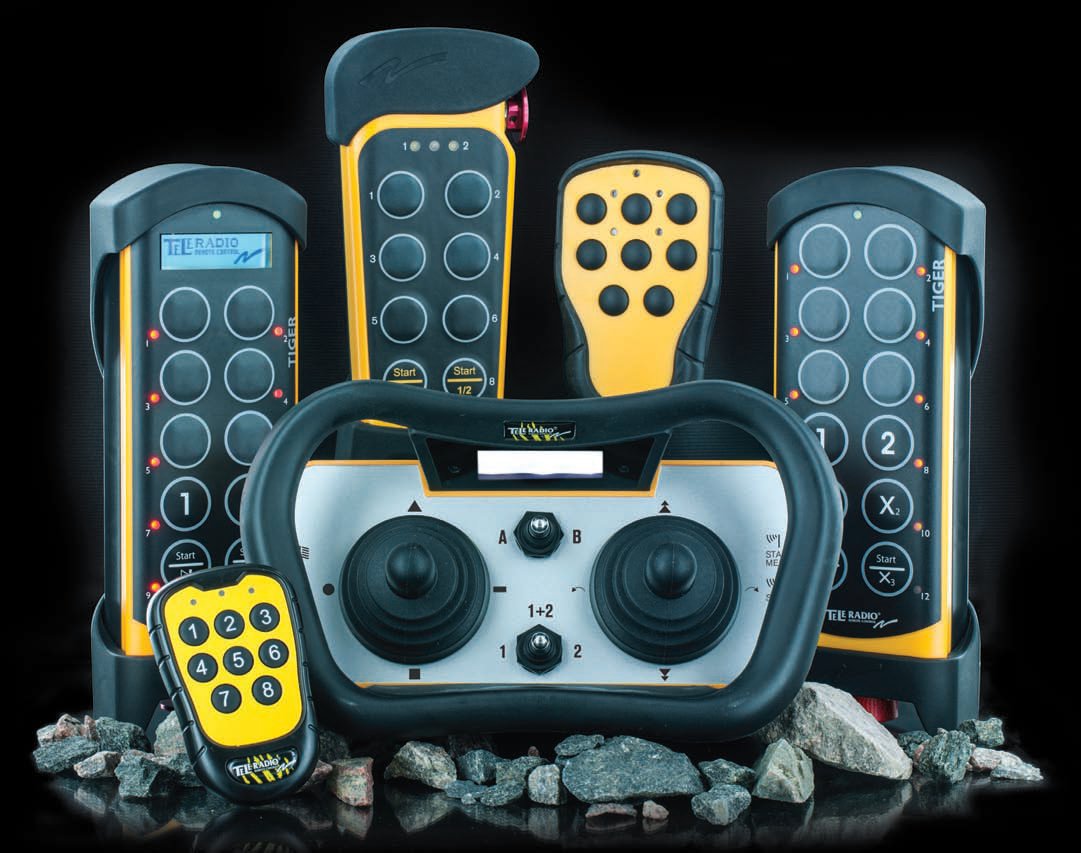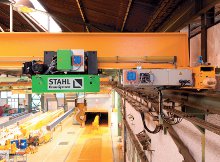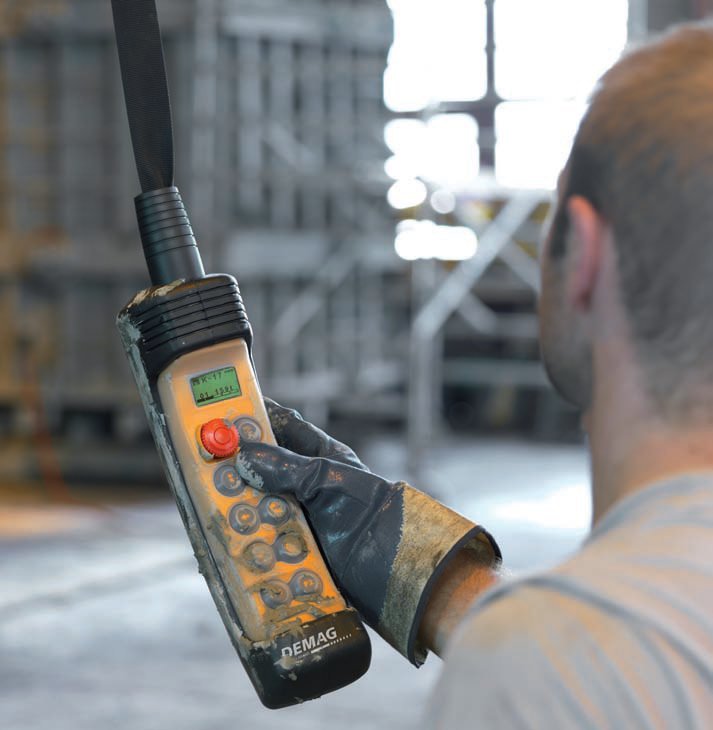Moving with the times
11 April 2014Cable free controls using radio or infrared are becoming the norm for controlling hoists and overhead cranes.
There was a time when most factory cranes were operated from a cab and smaller hoists and lifting machines from a console. Then came the pendant control on a cable freeing the operator to some extent from the machine and the area of the lift.
But connection free radio controls have since developed. These are gradually becoming the norm, offered by both larger hoist makers themselves and by third-party specialist suppliers. They provide even greater flexibility and safety, allowing the operator to be well clear of the area where an overhead or hoist is working and with no need to follow a machine along its path, stepping around other equipment.
Neither cab nor pendant will disappear, most suppliers believe, and for the moment still account for just over half the market. For certain specialised functions like handling hot metal crucibles in foundries, a cab operator using cab lever controls is considered best, and for smaller and infrequently used lifting devices the pendant might suffice.
But radio, or sometimes infrared, continues to grow for various reasons "and so far just seems to keep going" says marketing manager Kristian Karlsson at the Swedish firm Tele-Radio.
Complex systems
There are multiple reasons. Firstly the cost has come down and devices are nowadays almost comparable with pendants in price. Taken with the enhanced safety, and ease of use, adding to productivity, it tips the decision.
But there is also growing complexity of electronic systems which allows far more information to be transferred to and fro, to be displayed on hand or belly controls. "It's a burgeoning technology everywhere in consumer products as well as industrial" says Ben Stoller, marketing manager at the US company Magnetek, which makes a wide range of controllers.
In the computer age with a younger generation more au fait with game consoles and computers this is both wanted and accepted. "The displacement of the 'baby boomers' by younger workers is definitely a factor," agrees Eric Peterson, business development manager for Drivecon, which is part of R&M Materials Handling in the US, within the Konecranes group.
Drivecon concentrates on these systems for the North American market he says offering both off the peg and customised solutions. "These days they are also more and more part of an integrated control solution rather than an 'accessory'" he says.
Trends in the products include smaller and lighter weight units, with more ergonomic designs for both handheld controllers and in the receivers, and an increasing number of control functions possible. More two choice channels such as up down, left-right and so forth are provided for more functions but also variable controls to handle motor speed for example.
"Customers particularly want the capability to move the crane at very slow speeds" says Lars Elvind, technical sales manager with Tele-Radio.
Most makers now have a range of controllers from simple to complex. Operations by joystick are increasingly offered.
As the possibilities and complexities grow too, requiring more complex commands to be sent, so do safety issues. Although radio offers safer working distances it also brings new problems, in the way it works and the in the way it can go wrong.
These are varied but the main ones include the need to ensure that the controller and the machine it is operating stay together and particularly in large factories, where there might be dozens of different devices that the wrong machine is not started up.
The issue grows more important when the possibility is added for an operator to be able to operate different machines from the same handheld controller, or vice versa for a single hoist or crane to be taken over by another operator as it moves from floor to floor in a building for example.
Complex coding signatures are needed to identify that the right machine is picking up signals, and these have to be set up in such a way that there is no chance of duplications explains Antonio Silvestri, product development manager at Italian firm Autec. Autec was the first manufacturer in that country, and one with a reputation for taking the safety issues very seriously. He has previously written on the subject for Hoist magazine.
Then there is the problem of errors in the signal. Most remote controls operate by sending out short commands as strings of digital information, which are received at the machine to tell it what to do. But signals can be corrupted, and protocols have to be devised to ensure that different commands do not get mixed up because of a lost "bit", with complex electronic and software methods to ensure that commands can be checked and verified.
Two-way communication
This becomes even more complex when two way communication is added, using transceivers at the control box and on the machine, so that sensors indicating load, speed and other factors can relay information back for display on a screen, as well as to be recorded as data for details about machine usage, and perhaps maintenance condition.
The most basic issue of all is in the stop function, the ability to bring a hoist to a halt if something is wrong, vital when lifting and moving potentially deadly loads. Ensuring high safety levels in this requires more complexity than might be thought at first sight.
A very basic requirement is the "always on" condition for operating a controller so that it will automatically shut the link down and stop the machine if a connection is broken.
The reputable makers complain that cheaper equipment coming on to the market will use a system which only sends positive command signals but does not transmit in the meantime. It saves battery life, a "feature" sometimes highlighted, but with no failsafe.
There are further complexities for the stop function to ensure it must be positively operated and with a doubling up of the stop relays, to double check against jamming or failure. Beyond that, the controller and machine hardware is also set up so that if no signal is received within an allotted time, or signals are rejected because of possible errors, motors and winches will shut down. But systems relying on passive shutdown alone are not adequate.
Recent years have seen a wide range of product standards released in Europe, Japan and North America particularly to address these questions and the major manufacturers suggest buyers should always look for certification to the various standards, according to region, when they are procuring systems.
A difficulty for makers is that the standards are not completely harmonised in world terms, and they have to ensure products match the market. "But most of the European countries are similar and Australia too is converging with Europe" says Silvestri. North America, though different in some respects is also state-ofthe- art in its standards.
Radio interference
Another issue affecting both "stop" safety and integrity of the transmitted commands is interference with radio signals which can corrupt the command strings. It can come from external sources like arc furnaces or electrical substations, or simply from other machine control, "particularly as more and more devices are operated this way and including those arriving on lorries in loading yards and the like" says Silvestri.
Ways to overcome this problem include the use of multiple frequencies for controllers, and the ability to automatically switch frequencies to find the one with the least traffic or interference, and controllers offering this capacity have been appearing recently. Once again this requires makers to match specific protocols and European or American standards.
"But that is an older issue" suggests Elvind "and most makers can do that now." Use of higher frequencies helps overcome the problem too he says.
Higher frequencies also help with a final problem for radio which, ironically, its excellent transmission range. It often goes beyond the 150m recommended as the maximum for remote control Operation of equipment.
But though frequency and use of weakened signals restrain the signal range it is not always easily kept within bounds. "Not many people have completely got a handle on that" admits Ben Stoller at Magnetek.
It is not always a critical issue but "the danger is that cranes may start up out of the operator's vision, even without him knowing" says Bill Wood, managing director of British remote maker Command Chief "or even more, behind a partition or a wall."
His company almost uniquely has specialised in developing infrared signalling using LEDs in a way comparable to a TV "remote". He says the company has developed the technology considerably overcoming problems of high directionality and small range.
"But line of sight is still the point, because the machine cannot be switched on and operated without the person controlling it being within limited distance."
That has not just safety implications but is important for manufacturers of highly expensive items who do not want to risk an incident; examples include Airbus wing manufacture and Rolls-Royce aero-engines in the UK, both with his systems.
Some of the other radio control makers now install "infrared start-up" in their systems to ensure the control box is near the machine before it is switched on, and even that the radio controls only operate within an "infra-red" range "umbrella". But others says that the technology is old fashioned.
Wood however asks why use radio at all if infrared has advantages. He says the company has advanced the technology.
"We have no axe to grind and can produce our control systems in either radio or infrared" he says "though 60% of customers go for the infrared."
There are some drawbacks in special circumstances" he says, including close to welding equipment, which produces infrared noise. Those producing more radio based systems also point to the use outside where daylight has to be overcome. Wood responds that modern LEDs are much brighter.
But the methodology serves for both handheld controls and for inter-crane communications. A speciality of the company is systems for crane collision prevention, particularly in set-ups with multiple overheads.
"It works with a three zone speed reduction so that the crane gantries can safely be stopped just 30mm from each other without load swing."
The future looks like bringing much greater sophistication in both methods with variable controls, and software developments allowing combinations with maintenance and control systems.
Key products
Sweden's Tele-Radio offers a wide selection of both controllers and receivers, from small hand-helds to multibutton units and joystick belly units. They come in a half dozen ranges names after hunting cats, from Lynx to Jaguar. Overhead crane units are available for hoists from 7t to 100t capacity. Via 13 subsidiary companies they make and sell to OEMs and to enduser customers throughout the world. A key aspect of the units is that they comply with the EU and other regional safety standards says Kristian Larsson.
Latest product is the TG-T14-4 just being unveiled at the spring fair in Hanover in April and at Conexpo in the US. The unit is a 10-button transmitter with 6 analogue buttons for variable speed control and a display for feedback from data like speed, weight, RPM of the crane and battery time, frequency, signal strength for the controller.
Autec in Italy was founded more than three decades ago and began expanding into the southern European market soon afterwards, and now sells throughout Europe and worldwide. It emphasises robustness, reliability and innovation for its products and also places great store on safety aspects of the equipment operation. Latest developments include two way transmission for safety for reception of data on the control sets says product development manager Antonio Sylvestri.
Its major AIR range has compact, ergonomic handsets and an easily installed system its says.
Pushbutton handsets have 8, 6 or 4 buttons and the units comply with the EN ISO 13849-1 stop standard. Other features include PIN start up to prevents authorised use; automatic search for the working frequency; universal docking stations for recharging the Li-ion batteries. The lightweight units are tested for fall tests from 1.5 meters. They have 4 data feedback LEDs to display machine status and browsing menus for optimisation of functions and performance.
Waist level controllers also have up to 6 analogue outputs, an infrared alignment system, multi unit systems, and CAN and serial communication data feedback display.
Also from Italy is the IMET, founded in the late 1980s and also offering a wide range of controllers for industry and construction. In addition to the standard models the company says it offers customised models as required. The company manufactures to a high standard achieving category 2 and 3 for all movement commands and category 4 for the STOP circuit as required under UNI EN 954-1.
Among its range of products is the push-button WAVE family tailored for hoists and overhead travelling cranes on/ off controlled machines
Waist belt transmitters are aimed at joystick controllable machines. Control panels in the ZEUS family accommodate up to two double axis joysticks or six single axis joysticks in addition to push buttons, rotary switches and potentiometers.
Major recent trends include development of automatic frequency seeking says Allessandro Andean in the marketing department and multi-transmission and receiver stations.
Reliability and robustness
Drive-Con in Wisconsin in the US specialises in pendants, radio control and inverters says Eric Peterson, business development manager, offering both standard and customised products.
The radio controls are increasingly installed as part of a system he says rather than being sold as stand alone, as originally. "These are what you can call, smart systems more and more."
Key developments at present too are improvements in ergonomics and weight especially with lighter weight units. Reliability and robustness are important and the firm offers a two-year warranty for its PWR Link radio range.
The range features 2.4 GHz frequency with its FCC and IC approved; has a globally open frequency band (except in Japan) and IP65 protection (NEMA 4 type). There are 16 field programmable bands with 5MHz spacing. Constant carrier communication means for superior integrity of crane operator commands
Up to 250 units possible within a single facility the company says.
Smaller and lighter units are the focus for Magnetek says director of radio controls Ben Stoller, along with multiuse units and feedback from equipment. Among a wide range of units there is the newly launched Telemotive MBT a small compact bellybox which offers control options usually found in larger transmitters. These include a graphic display, proportional thumb sticks, FHSS RF, and two-way feedback.
The unit was originally aimed at the mobile hydraulic market and has been a major success. It is now being offered for overhead material handling customers for crane and hoist applications it says.
Many different combinations of toggles, selector switches, and potentiometers are available says the company and the graphic display can be adjusted for status updates and machine information customised for most applications. It has a rugged nylon housing to withstand shock and harsh industrial environments.
At Germany's HBC-Radiomatic, head of product management, Alexander Hemming says the firm has two new models for the lifting industry, the Technos 2 and the Spectrum E.
The Technos 2 features colour display on a 3.5? screen to indicate operational data. Among other new features is the optional Radiomatic® Photon, which offers viedo camera assistance for precise, and safer, work in areas with limited view. The mew ,mpde; cam also be supplied with various combinations of up to 3 HBC joysticks, with z-axis switches for three drive commands on each, up to 8 linear levers, and other switches and buttons.
The long-life of the units is "excellent" he says with up to 18 hours of continuous operating time even with the display activated. Power is provided by a newly developed Li-ion exchange battery which can be changed "in just a few seconds with a few simple steps" he says if an even longer working period is required. There is a range of Smart Options, like an integrated LED flashlight, user identification with data logger, and a micro / orthogonal drive for demanding manoeuvres. There are several fully or partially automated frequency management systems.
Spectrum E is a high-end version of the existing Spectrum series he says and is a unit with space for a large number of operating elements designed for complex applications with more functions than usual. To reduct operator fatigue the unit has a redesigned and more compact housing reducing the weight to 3.5kg, almost half previous comparable models.
Up to 6 joysticks can be supplied or 10 linear levers as well as further push buttons, or toggle or rotary switches including maintained/spring-return contact. It also features an individually configurable 3.5? colour screen for machine data, status information, and warnings and has a new Li-ion exchange battery to give a claimed maximum 18 hours continuous operation.
Major manufacturer Terex Demag in Germany produces its own range of radio controls fitted to its extensive hoist and factory movement crane ranges. Among its equipment is the DRC-DC radio remote control system which is aimed at optimal ergonomic operation of its chain hoists and is specifically designed for them.
Transmitters available in two sizes, and up to two or three motion axes can be controlled with either the DRC-DC 6 or DRC-DC 10. German hoist maker Stahl also produces its own radio control systems for its wide range of hoists.
Commander Controls in the UK produces both infra-red and radio remote control systems as well as crane to crane communication and control systems for collision prevention. "The units use either technology and externally look very similar, but we prefer the infrared technology and have concentrated development work in the this area" says managing director Bill Wood. Orders are supplied around the world including steel makers in Korea and steel stockyards in Australia, though a significant part of the market is in the UK. Major clients include aerospace and heavy industrial clients some with highly specialist needs.
Many of its systems are fitted onto and designed in conjunction with Street Cranes.One recent order just in commissioning has been for scrap and finished steel product warehousing at Redcar for steel firm Tata. Some eight overhead Stret cranes are being used including four cranes with a complex configuration of twin parallel beams, with a separate beam running at right angles between them carrying twin hoists for tandem lifts of long steel components.
To configure and control a crane type like this would normally require a drapery of cables and wires usually hanging in loops beneath the cranes to provide the coverage for the crane movements. "The cables can fail through constant flexing or get snagged and ripped," says Wood.
His firm supplies a control system trade-marked XBData system which uses infrared transmissions for communicating says Wood. It is installed together with one of the company's standard remote control system.
This has been fitted on both the more complex crane and the simpler bridge cranes being used at the facility. Each hoist has a single receiver decoder sized for the number of output commands required. An enclosed conductor bar runs on each crane bridge to supply 415V power.
